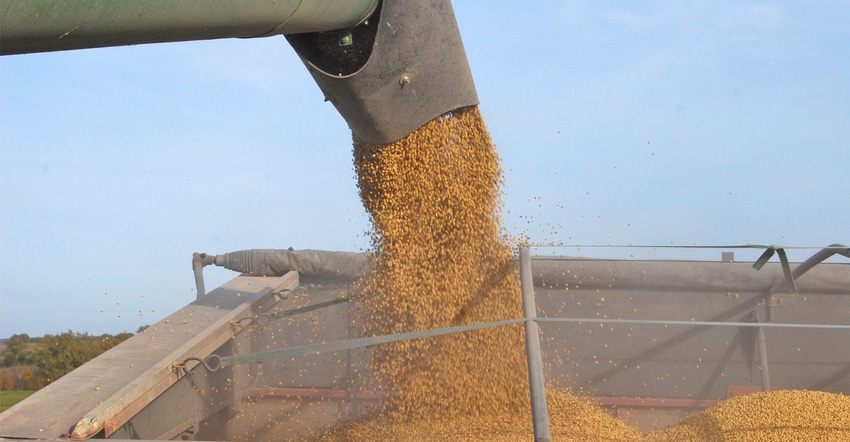October 31, 2019

Temperatures fell into the low 30s and upper 20s in most of Iowa on Oct. 11-13. Because of the very late planting season this year, some soybeans were immature enough this fall to be injured by the freezing temperatures. Thus, more farmers than usual are raising questions about handling, storing and marketing frost-damaged soybeans.
“Frost normally forms early in the morning, driven by radiation cooling especially on clear, cold nights,” says Charlie Hurburgh, professor in charge of the Iowa Grain Quality Initiative at Iowa State University. “The visual impact of the frost damage is most evident the next day. You’ll see soybean plants with shriveled and discolored leaves.”
Temperatures below 32 degrees F can damage soybean leaves, and temperatures below 30 degrees for extended time periods can damage stems, pods and seeds. “A killing freeze is considered to be 28 degrees for soybeans,” notes ISU Extension field agronomist Meaghan Anderson.
Frost damage varies
Beans often lose their green color within two weeks of maturity, so you should allow the beans in the field to dry down naturally, if possible, Hurburgh says. This same statement is true of plants that were only partially frosted (generally on upper leaves).
The severity of frost damage to soybeans depends on several things, including how low the temperatures dropped, duration of the cold temperatures and the growth stage of the soybeans, Anderson says. Soybean fields with at least one mature pod on the main stem of each plant (R7 growth stage) are likely to be minimally affected by frost. Plants with green pods will be more affected by frost. If the frost just damaged soybean leaves, particularly in the upper canopy, pods and seeds will continue to develop with yield minimally affected.
If the frost was more severe and damaged the stems, pods and seed, the potential for reduced yield and quality is higher, notes ISU agronomist Rebecca Vittetoe. In addition to reduced yield and quality, severely frost-damaged soybeans will dry down more slowly and be more likely to shatter at harvest. Farm moisture meters and older elevator meters will read about 1.5% to 2% lower than what they should until moisture and color have equalized. The new 150-MHz meters used by many elevators are more accurate.
Handling frost-damaged beans
If you do have frost damage to your soybeans, it is suggested to not sell the soybeans immediately as this is when the soybeans will have the most grain discoloration and highest moisture. They will appear worse than they will end up after aeration, Hurburgh says. Instead, if you do harvest the field shortly after a frost, it is recommended to put the soybeans in an aerated bin. With air and drying, the green discoloration will subside somewhat over time.
What about grain grading of frost-damaged soybeans? Green damage (frost) is an official damage category in the USDA grades. Green color will result in price discounts. However, the greenness must be fairly intense and comprehensive to be classified as damaged. Check USDA’s website for information and photos of frost damage.
The green soybean seeds and pieces of soybeans that are discolored green with an area of coverage and intensity equal to or greater than shown at the link above are considered as green damaged by USDA.
Processors will be concerned about green soybeans because of the likely lower oil yield and the need to remove the green color from the oil by more intensive refining, Hurburgh says. While some processors use official federal graders, there will likely be problems in grading, as local markets may call anything somewhat green as “damaged.”
Federal graders are trained in color differentiation. Five samples or more, with varying degrees of greenness, can be taken to an official federal grader to “calibrate” house grading.
Be careful when drying
Because immature soybeans are deceptively wet, problems often occur. Hurburgh recommends cleaning the beans before storage to remove wetter weed seeds and plant parts. Two to four weeks of steady aeration will both reduce moisture levels and cause greenness to partially subside. Check the condition of stored soybeans frequently.
Also, pay attention to harvest moisture content. You can dry wet beans. If they are below 15% to 16% moisture, you can usually dry them with unheated natural air if there’s lower humidity and no rain. Air-dried beans can store well if dried properly, Hurburgh says. Keep in mind if beans start to spoil in storage, the situation can be difficult to get back under control — even with running a grain dryer. The oil in soybeans makes it more difficult to dry them compared to corn.

To safely store soybeans through winter, you should dry good-quality beans to 13% moisture. To store into the warmer summer months, dry soybeans to 11%. You can artificially dry soybeans, but use temperatures of less than 130 degrees F, which are considerably lower than temperatures for corn drying. For frost-damaged corn, high temperature drying should be limited to 160 degrees or less, Hurburgh says.
More information is available in ISU Extension publication Frost Damage to Corn and Soybeans, PM 1635.
About the Author(s)
You May Also Like






